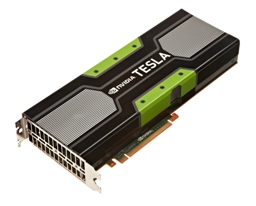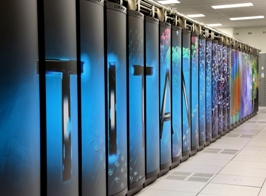
NVIDIA ha presentato oggi la famiglia di GPU NVIDIA Tesla K20, gli acceleratori più efficienti e con le più elevate performance mai realizzati e su cui si basa Titan, il più veloce supercomputer al mondo secondo la TOP500 list presentata questa mattina alla SC12 supercomputing conference.
Equipaggiato con 18,688 acceleratori GPU NVIDIA Tesla K20X, il supercomputer Titan dell'Oak Ridge National Laboratory a Oak Ridge si è attestato come il supercomputer N. 1 nella classifica mondiale davanti al sistema Sequoia del Lawrence Livermore National Laboratory’s con le performance record di 17.59 petaflop misurate con il benchmark LINPACK.1
Tesla K20 – Leadership per performance ed efficienza energetica
Basata sulla rivoluzionaria architettura NVIDIA Kepler, la nuova famiglia Tesla K20 include l'acceleratore Tesla K20X, il prodotto di punta della linea NVIDIA Tesla.
Assicurando le più elevate performance disponibili con un singolo processore, la K20X decuplica l'accelerazione quando accoppiata a CPU leader.2 Sorpassa tutti gli altri processori su due classiche misure delle performance computazionali– (potenza di picco di 3.95 teraflop con calcoli in virgola mobile di singola precisione e 1.31 teraflop in doppia precisione).
La nuova famiglia include anche l'acceleratore Tesla K20, che offre 3.52 teraflop di potenza di picco in singola precisione e 1.17 teraflop in doppia-precisione. Negli ultimi 30 giorni sono già state distribuite GPU Tesla K20X e K20 che assieme totalizzano 30 petaflop. Ciò equivale alle somma delle performance computazionali dei più veloci supercomputer degli ultimi 10 anni messi insieme.
"Stiamo beneficiando delle architetture basate su GPU NVIDIA per accelerare in modo significativo le simulazioni in numerose e diverse aree come, ad esempio, il clima e la metereologia, la sismologia, l'astrofisica, la meccanica dei fluidi, le scienze e la biofisica molecolare.", ha affermato Dr. Thomas Schulthess, professor of computational physics presso ETH Zurich e Direttore del Swiss National Supercomputing Center. "La famiglia di acceleratori K20 rappresenta un balzo in avanti nel computing comparabile a quello apportato dalla precedente architettura NVIDIA Fermi, aumentando la produttività e consentendoci potenzialmente di raggiungere prospettive finora impossibili.”
Altri utilizzatori della prim'ora sono: Clemson University, Indiana University, Thomas Jefferson National Accelerator Facility (Jefferson Lab), King Abdullah University of Science and Technology (KAUST), National Center for Supercomputing Applications (NCSA), National Oceanic and Atmospheric Administration (NOAA), Oak Ridge National Laboratory (ORNL), University of Southern California (USC) e Shanghai Jiao Tong University (SJTU).
Efficienza energetica per data center più "green"
L'acceleratore GPU Tesla K20X offre tre volte l'efficienza energetica della precedente generazione e garantisce, se paragonato alle CPU, maggiori benefici.
Utilizzando gli acceleratori Tesla K20X, Titan di Oak Ridge ha ottenuto 2,142.77 megaflop di performance per watt, che supera i livelli d'efficienza del sistema N.1 della più recente classifica Green500 dei supercomputer più efficienti al mondo.3
La soluzione più veloce con un'ampia gamma di applicazioni Data Center
La famiglia Tesla K20 accelera la più vasta gamma di applicazioni commerciali, ingegneristiche e scientifiche per high performance computing e data center. Oggi, oltre 200 applicazioni software traggono vantaggio dall'accelerazione su GPU, con un aumento del 60% in meno di un anno.
Quando gli acceleratori GPU Tesla K20X vengono aggiunti ai server con CPU Intel Sandy Bridge, molte applicazioni vengono accelerate di 10 volte o più, come, ad esempio:4
- MATLAB (engineering) – 18.1 volte più veloce
- Chroma (physics) – 17.9 volte più veloce
- SPECFEM3D (earth science) – 10.5 volte più veloce
- AMBER (molecular dynamics) – 8.2 volte più veloce
Maggiori informazioni sugli acceleratori Tesla K20 sono disponibili presso lo stand NVIDIA 2217 a SC12, Nov. 12-15, e sul sito NVIDIA dedicato all'high performance computing. E' possibile provare gratuitamente in remoto l'acceleratore Tesla K20 sui cluster dal sito GPU Test Drive.
Disponibilità
La famiglia degli acceleratori NVIDIA Tesla K20 è disponibile presso i principali produttori, tra cui Appro, ASUS, Cray, Eurotech, Fujitsu, HP, IBM, Quanta Computer, SGI, Supermicro, T-Platforms e Tyan e anche dagli NVIDIA reseller.

[Immagine ad alta risoluzione]

[Immagine ad alta risoluzione]

NVIDIA today unveiled the NVIDIA Tesla K20 family of GPU accelerators, the highest performance, most efficient accelerators ever built, and the technology powering Titan, the world's fastest supercomputer according to the TOP500 list released this morning at the SC12 supercomputing conference.
Armed with 18,688 NVIDIA Tesla K20X GPU accelerators, the Titan supercomputer at Oak Ridge National Laboratory in Oak Ridge, Tenn. seized the No. 1 supercomputer ranking in the world from Lawrence Livermore National Laboratory's Sequoia system with a performance record of 17.59 petaflops as measured by the LINPACK benchmark.(1)
Tesla K20 - Performance, Energy-Efficiency Leadership
Based on the revolutionary NVIDIA Kepler compute architecture, the new Tesla K20 family features the Tesla K20X accelerator, the flagship of NVIDIA's Tesla accelerated computing product line.
Providing the highest computing performance ever available in a single processor, the K20X provides tenfold application acceleration when paired with leading CPUs.(2) It surpasses all other processors on two common measures of computational performance -- 3.95 teraflops single-precision and 1.31 teraflops double-precision peak floating point performance.
The new family also includes the Tesla K20 accelerator, which provides 3.52 teraflops of single-precision and 1.17 teraflops of double-precision peak performance. Tesla K20X and K20 GPU accelerators representing more than 30 petaflops of performance have already been delivered in the last 30 days. This is equivalent to the computational performance of last year's 10 fastest supercomputers combined.
"We are taking advantage of NVIDIA GPU architectures to significantly accelerate simulations in such diverse areas as climate and meteorology, seismology, astrophysics, fluid mechanics, materials science, and molecular biophysics," said Dr. Thomas Schulthess, professor of computational physics at ETH Zurich and director of the Swiss National Supercomputing Center. "The K20 family of accelerators represents a leap forward in computing compared to NVIDIA's prior Fermi architecture, enhancing productivity and enabling us potentially to achieve new insights that previously were impossible."
Additional early customers include: Clemson University, Indiana University, Thomas Jefferson National Accelerator Facility (Jefferson Lab), King Abdullah University of Science and Technology (KAUST), National Center for Supercomputing Applications (NCSA), National Oceanic and Atmospheric Administration (NOAA), Oak Ridge National Laboratory (ORNL), University of Southern California (USC), and Shanghai Jiao Tong University (SJTU).
Energy-Efficiency for "Greener" Data Centers
The Tesla K20X GPU accelerator delivers three times higher energy efficiency than previous-generation GPU accelerators and widens the efficiency advantage compared to CPUs.
Using Tesla K20X accelerators, Oak Ridge's Titan achieved 2,142.77 megaflops of performance per watt, which surpasses the energy efficiency of the No. 1 system on the most recent Green500 list of the world's most energy-efficient supercomputers.(3)
Fastest on Broadest Range of Data Center Applications
The Tesla K20 family accelerates the broadest range of scientific, engineering and commercial high performance computing and data center applications. Today, more than 200 software applications take advantage of GPU-acceleration, representing a 60 percent increase in less than a year.
When Tesla K20X GPU accelerators are added to servers with Intel Sandy Bridge CPUs, many applications are accelerated up to 10x or more, including:(4)
- MATLAB (engineering) - 18.1 times faster
- Chroma (physics) - 17.9 times faster
- SPECFEM3D (earth science) - 10.5 times faster
- AMBER (molecular dynamics) - 8.2 times faster
More information about the Tesla K20 GPU accelerators is available at NVIDIA booth 2217 at SC12, Nov. 12-15, and on the NVIDIA high performance computing website. Users can also try the Tesla K20 accelerator for free on remotely hosted clusters. Visit the GPU Test Drive website for more information.
Availability
The NVIDIA Tesla K20 family of GPU accelerators is shipping today and available for order from leading server manufacturers, including Appro, ASUS, Cray, Eurotech, Fujitsu, HP, IBM, Quanta Computer, SGI, Supermicro, T-Platforms and Tyan, as well as from NVIDIA reseller partners.
News Source: NVIDIA Press Release
Links
|